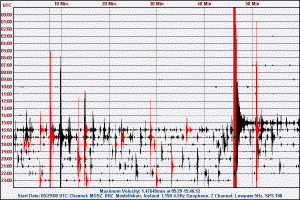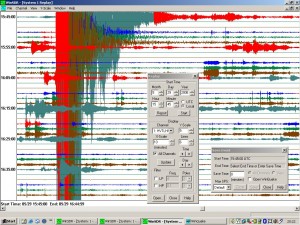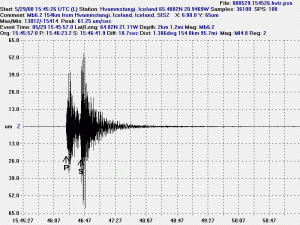Many people don’t know how to spot a earthquakes on my helicorders web site (you can view it here). Here is a quick how-to. The earthquake used is a Mw6.3 earthquake that did happen in 2008 in Iceland.

The second the earthquake did hit the sensor. The green line is when the power did go down in my apartment, just moment before the earthquake. Before that you can see background noise. That is people, cards and stuff like that. The earthquake is the big black-red line on the helicorder. After that you see smaller earthquakes happening (mag 3+ in size). This Hvammstangi geophone

Same earthquake, different location. This station actually was low-gain at the time of the earthquake. But meant that it was less sensitive to smaller earthquakes then larger. But the aftershock can be seen clearly on the helicorder at the time.

This is how my earthquake computer screen looked like at the time. The top line is currently not in use, as it is for a long period seismometers and I was just testing it at the time (it is also unclear on the signals as can be seen). The second and the third line in use is my geophone. But it clearly showed the earthquake and all it’s waves.

The Mosfellsbær station. That I had connection to at the time. But this is rather crazy view, as this is earthquakes and it is a lot of earthquakes in short space of time. I soon gave up trying to collect them.

This is how I finally work out the earthquakes. I put in location and depth from IMO data, as I can’t plot them my self.
I hope that this examples help people to see when there is a earthquake on my helicorder and just noise from human movement. Harmonic tremors are different and so far I have not been able to get any good example of it. But during the Eyjafjallajökull eruption a wind was problematic and I was unsure if I was recording wind into the harmonic tremors of that eruption or not. So that is going to have to wait a better time.

Thank you Jón. I think I have already learned how to spot earthquakes on your helicorders, by comparing nearby events reported by IMO with spikes in there.
What I cannot quite tell is winds from noise. This past day, for example, the winds graphs were stopped at very low values, but the helicorder line shows a steady “oscillation”, which doesn’t look like local noise to me. Are winds to be blamed?
Thanks in advance
@Renato Rio, On the Hekla geophone there have been wind all day. But also two earthquakes. On my Hvammstangi sensor it has just been human noise making spikes on it. It has been quiet earthquake wise on that geophone. But it is in a quiet area, so that is not a surprise.
How about this one? Doesn’t show in the Helicorders?
Tuesday
19.10.2010 01:54:28 63.666 -19.178 5.1 km 2.0 90.02 4.6 km NE of Goðabunga
I did barely see it on my live plot on earthquake PC. But it is really hard to spot. Looks like a high frequency event. But this is in a area that has been moving (they think) for some unknown reasons over the past few weeks.
But I have already made a new post about recent earthquakes in Katla volcano. Please check that post out for more information.
Thanks for the explanation. But you have one advantage: You can see the high resolution data on you computer, while the view on the webpage is limited in resolution.